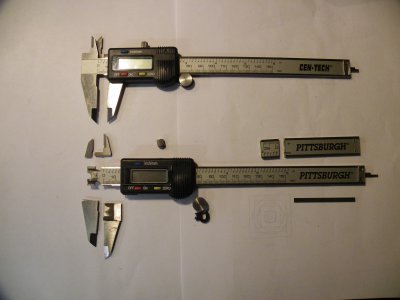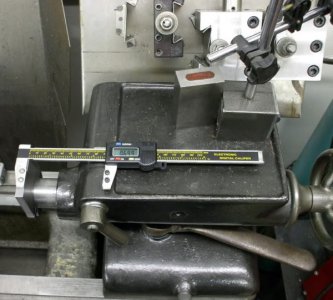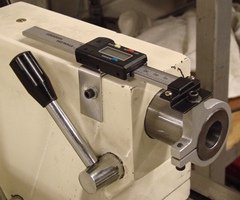- Joined
- Sep 4, 2013
- Messages
- 99
$10 Calipers to DRO
Having studied the workings of digital calipers, I realized that they could be trimmed to make perfectly functional DRO’s. Harbor Freight has these for sale, with a coupon, for $10. The pictures show what has to be trimmed off leaving behind the LCD Screen with the depth blade and the sliding ruler.
I used a Dremel tool with a cutoff blade and it took less than 10 minutes to finish removing the non-essentials.
I needed a DRO for the tailstock ram on my lathe, but it had a travel of about 3 inches. I trimmed off the sliding ruler to the length I needed and it continued to work just fine.When I had finished trimming, I put the sliding ruler on my mill and used a carbide mill to clean up the rough edges. The Dremel would have done a serviceable job, too.
The rulers are made of hardened steel and I had nothing that would drill through it. I used the edge of the cut-off wheel to carve half-round notches in the sides of the sliding ruler which just accepted half of a screw. When the sliding rule was placed on the bracket, the notches lined up with the screw holes and the sliding rule was secured. The depth blade was clamped in position and everything worked just fine. The notches can be seen on the left end of the sliding rule below.
The only other modification I would recommend is to glue a piece of transparent plastic over the LCD screen since it is a little delicate. You might also consider putting the LCD screen in a fixed location and have the sliding rule move.

Having studied the workings of digital calipers, I realized that they could be trimmed to make perfectly functional DRO’s. Harbor Freight has these for sale, with a coupon, for $10. The pictures show what has to be trimmed off leaving behind the LCD Screen with the depth blade and the sliding ruler.
I used a Dremel tool with a cutoff blade and it took less than 10 minutes to finish removing the non-essentials.
I needed a DRO for the tailstock ram on my lathe, but it had a travel of about 3 inches. I trimmed off the sliding ruler to the length I needed and it continued to work just fine.When I had finished trimming, I put the sliding ruler on my mill and used a carbide mill to clean up the rough edges. The Dremel would have done a serviceable job, too.
The rulers are made of hardened steel and I had nothing that would drill through it. I used the edge of the cut-off wheel to carve half-round notches in the sides of the sliding ruler which just accepted half of a screw. When the sliding rule was placed on the bracket, the notches lined up with the screw holes and the sliding rule was secured. The depth blade was clamped in position and everything worked just fine. The notches can be seen on the left end of the sliding rule below.
The only other modification I would recommend is to glue a piece of transparent plastic over the LCD screen since it is a little delicate. You might also consider putting the LCD screen in a fixed location and have the sliding rule move.



